Unit 3 Diverse Cultures Listening and Talking课件(共18张PPT) 2024-2025学年高一英语人教版(2019)必修3
文档属性
| 名称 | Unit 3 Diverse Cultures Listening and Talking课件(共18张PPT) 2024-2025学年高一英语人教版(2019)必修3 | 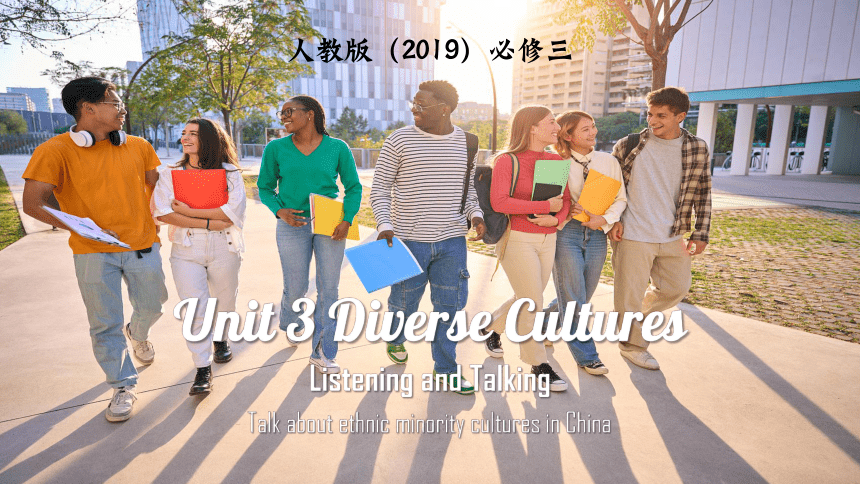 | |
| 格式 | pptx | ||
| 文件大小 | 35.4MB | ||
| 资源类型 | 教案 | ||
| 版本资源 | 人教版(2019) | ||
| 科目 | 英语 | ||
| 更新时间 | 2025-05-22 17:26:36 | ||
图片预览

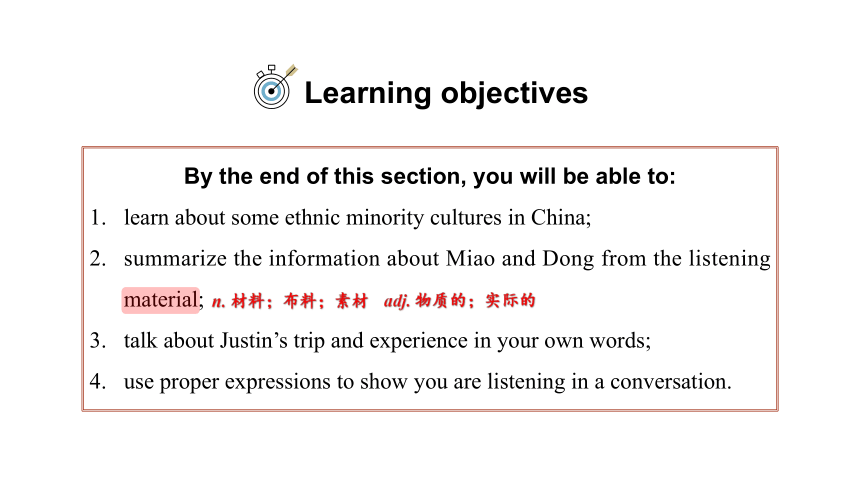
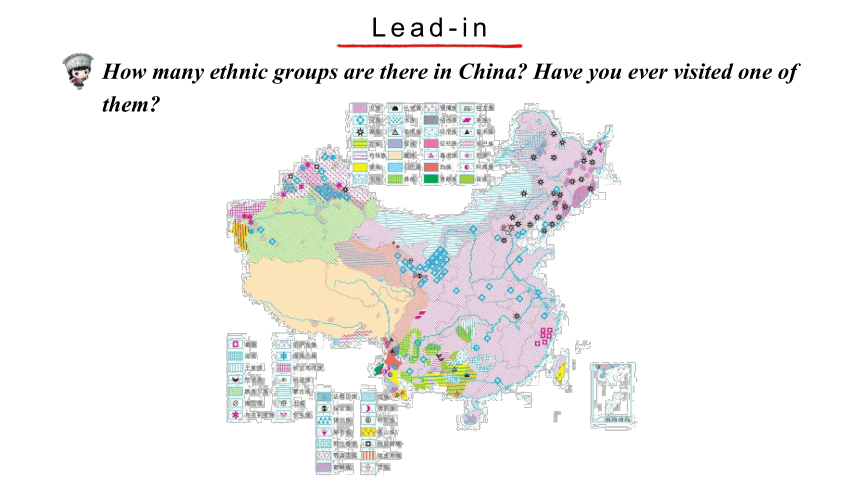
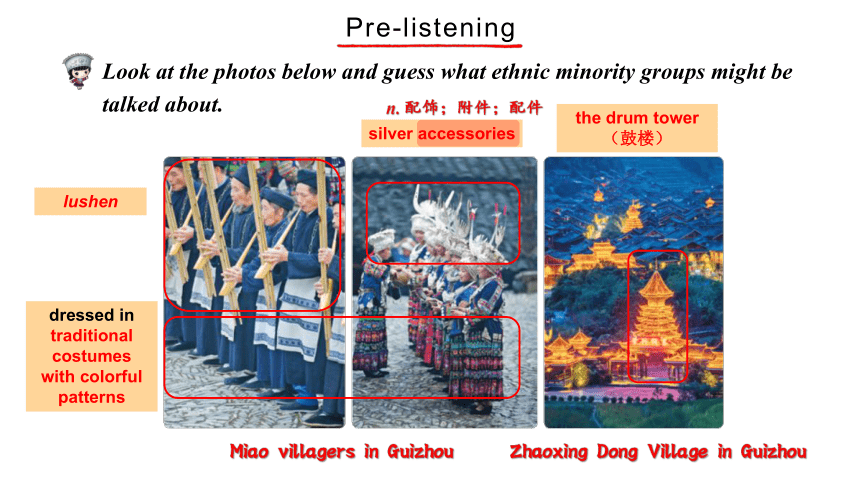

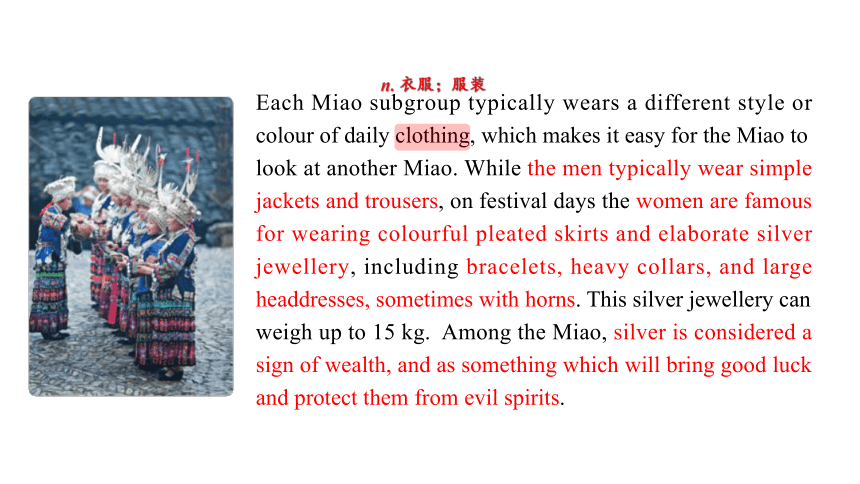
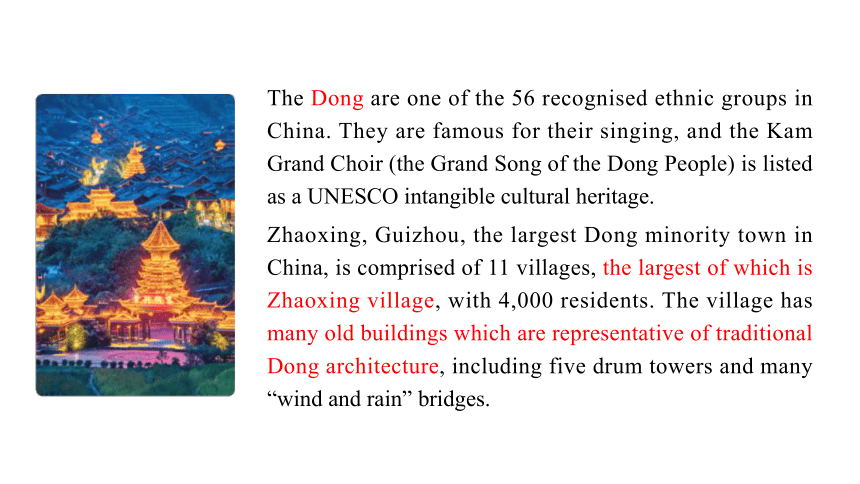
文档简介
(共18张PPT)
人教版(2019)必修三
Unit 3 Diverse Cultures
Listening and Talking
Talk about ethnic minority cultures in China
Learning objectives
By the end of this section, you will be able to:
learn about some ethnic minority cultures in China;
summarize the information about Miao and Dong from the listening material;
talk about Justin’s trip and experience in your own words;
use proper expressions to show you are listening in a conversation.
n. 材料;布料;素材 adj. 物质的;实际的
Lead-in
How many ethnic groups are there in China Have you ever visited one of them
Look at the photos below and guess what ethnic minority groups might be
talked about.
lushen
silver accessories
dressed in traditional costumes with colorful patterns
Miao villagers in Guizhou
the drum tower
(鼓楼)
Zhaoxing Dong Village in Guizhou
Pre-listening
n. 配饰;附件;配件
An important musical instrument for the Miao and Dong peoples is the lusheng, which is made up of bamboo pipes, each with its own reed. Every year, the Miao hold various lusheng festivals where people from local villages will gather wearing traditional costumes and show off their skills playing the lusheng, with many people joining in with traditional dance. The largest of these festivals takes place in Kaili, Guizhou every year in March, and includes other activities such as bullfighting and horse racing.
Each Miao subgroup typically wears a different style or colour of daily clothing, which makes it easy for the Miao to look at another Miao. While the men typically wear simple jackets and trousers, on festival days the women are famous for wearing colourful pleated skirts and elaborate silver jewellery, including bracelets, heavy collars, and large headdresses, sometimes with horns. This silver jewellery can weigh up to 15 kg. Among the Miao, silver is considered a sign of wealth, and as something which will bring good luck and protect them from evil spirits.
n. 衣服;服装
The Dong are one of the 56 recognised ethnic groups in China. They are famous for their singing, and the Kam Grand Choir (the Grand Song of the Dong People) is listed as a UNESCO intangible cultural heritage.
Zhaoxing, Guizhou, the largest Dong minority town in China, is comprised of 11 villages, the largest of which is Zhaoxing village, with 4,000 residents. The village has many old buildings which are representative of traditional Dong architecture, including five drum towers and many “wind and rain” bridges.
The Miao ethnic group has a population of more than 9 million, most of whom live in Guizhou province.
silver accessory
embroidery(刺绣)
sour soup fish
tricolor rice
The Miao ethnic group is well-known for their music and dance.
lusheng dance
Zhaoxing, Guizhou, the largest Dong minority town in China, consists of 11 villages, the largest of which is Zhaoxing village.
Drum Towers
Wind and Rain Bridges
The Grand Song of the Dong ethnic group
(侗族大歌)
While-listening
Justin met a new friend while travelling in Guizhou. Listen to their conversation and complete the summaries below.
(点击播放音频)
Part 1
Justin and _______ watched some _____ people play the _______. The instrument has a history of over ______ years and it is even mentioned in the oldest collection of Chinese poetry. Then they watched the ____________. Justin wanted to buy some hand-made _______________ accessories as souvenirs. He was told that the price will depend on the percentage of _______.
Part 2
They will go to a pretty ____ village called ________. They will see the __________ and the _________________. They may also see a performance of ______________
_______________.
Wu Yue
Miao
lusheng
3,000
lusheng dance
traditional / silver
silver
Dong
Zhaoxing
drum towers
wind and rain bridges
the Grand Song of
the Dong People
n. 作品集;收集物;收藏品
n. 纪念物;纪念品
n. 百分率;百分比
LISTENING PART 1
Justin: Hey, Wu Yue, do you know what kind of instrument these Miao performers are playing
Wu Yue: Yes, it’s called a lusheng, my favourite musical instrument.
Justin: It sounds beautiful. Is it made of bamboo
Wu Yue: Yes. Can you guess when it was invented
Justin: Um ... five hundred years ago I can’t tell. I know China has a very long history.
Wu Yue: That’s a good guess, but the lusheng actually has a history of over 3,000 years. It’s even mentioned
in the oldest collection of Chinese poetry.
Justin: Wow, such a long time ago. There must be many beautiful songs.
Wu Yue: Yes. indeed, and they all make me proud. You know. I’m a Miao, too, and I’m really proud of our
culture. Look, the performers are performing the lusheng dance. [Music.]
Justin: This is great! And I really like the silver accessories that the girls are wearing. What are they
Wu Yue: Oh, they’re traditional hand-made accessories. I can help you buy some as souvenirs if you like.
Justin: Great, thanks! I hope they’re not too expensive.
Wu Yue: Oh, well, it’ll depend on the percentage of silver.
Transcript
LISTENING PART 2
[A few minutes later:]
Justin: Great, now I have my souvenirs. So where are we going next, Wu Yue
Wu Yue: I’m taking you to Zhaoxing, a pretty Dong minority village. It’s considered one of China’s
most beautiful villages.
Justin: Great, I can’t wait. There must be a lot to see.
Wu Yue: There is. First, I’ll take you to see the beautiful drum towers, and then the wind and rain
bridges. The Dong play the lusheng, too. Perhaps you’ll see them perform the Grand Song of
the Dong People. Believe me, you’ll love it.
Justin: Wow, I’m really looking forward to it now.
Showing you are listening
Exactly! You’re right! I see. I know what you mean.
No way! You’re kidding! Really I can’t believe it!
Great!/Super! That’s interesting. Wow! Tell me about it!
Post-listening
If you are listening to others, what will you say
Expressions of agreement:
Expressions of disbelief:
Expressions that show feelings:
Encouragement to say more:
Exactly! You’re right! I see. I know what you mean.
You’re kidding! Really I can’t believe it!
Great!/Super! That’s interesting. Wow!
Tell me about it!
Talking
Work in groups. Imagine Justin is telling some friends about his trip to Guizhou. One of you is Justin and the rest of you are his friends. Ask Justin questions about his trip and experience. The following expressions may help you.
Sample
Phil: So, Justin, how was your trip to Guizhou
Justin: It was great. I went to this Miao village.
Robyn: I see. What was that like
Justin: People were dressed up in these wonderful ethnic costumes, and some men were playing a musical instrument called a lusheng.
Bill: Tell me about it!
Justin: The lusheng is made of bamboo, and it was invented more than 3,000 years ago.
Phil: Wow! That’s interesting.
Justin: Yes, it is. Then I bought some souvenirs made out of silver.
Robyn: You’re kidding! Were they expensive
Justin: Well, these weren’t that expensive. They don’t really have that much silver in them.
The instrument has a history of over 3,000 years and it is even mentioned in the oldest collection of Chinese poetry. (P31)
这种乐器有3000多年的历史,甚至在中国最古老的诗集中也有提及。
collection /k lek n/ n. 作品集;收集物;收藏品
搭配
a collection of+可数名词复数 一批……,一群……
例句
Two years ago he published a collection of short stories.
两年前,他出版了短篇小说集。
A collection of paintings by different famous painters is on show at the Museum of Art.
一批由不同的著名画家创作的绘画作品正在艺术博物馆展出。
Language points
Homework
Read the conversation aloud.
Talk about ethnic minority cultures you have experienced with your partners. Pay attention to use expressions we have learnt today.
人教版(2019)必修三
Unit 3 Diverse Cultures
Listening and Talking
Talk about ethnic minority cultures in China
Learning objectives
By the end of this section, you will be able to:
learn about some ethnic minority cultures in China;
summarize the information about Miao and Dong from the listening material;
talk about Justin’s trip and experience in your own words;
use proper expressions to show you are listening in a conversation.
n. 材料;布料;素材 adj. 物质的;实际的
Lead-in
How many ethnic groups are there in China Have you ever visited one of them
Look at the photos below and guess what ethnic minority groups might be
talked about.
lushen
silver accessories
dressed in traditional costumes with colorful patterns
Miao villagers in Guizhou
the drum tower
(鼓楼)
Zhaoxing Dong Village in Guizhou
Pre-listening
n. 配饰;附件;配件
An important musical instrument for the Miao and Dong peoples is the lusheng, which is made up of bamboo pipes, each with its own reed. Every year, the Miao hold various lusheng festivals where people from local villages will gather wearing traditional costumes and show off their skills playing the lusheng, with many people joining in with traditional dance. The largest of these festivals takes place in Kaili, Guizhou every year in March, and includes other activities such as bullfighting and horse racing.
Each Miao subgroup typically wears a different style or colour of daily clothing, which makes it easy for the Miao to look at another Miao. While the men typically wear simple jackets and trousers, on festival days the women are famous for wearing colourful pleated skirts and elaborate silver jewellery, including bracelets, heavy collars, and large headdresses, sometimes with horns. This silver jewellery can weigh up to 15 kg. Among the Miao, silver is considered a sign of wealth, and as something which will bring good luck and protect them from evil spirits.
n. 衣服;服装
The Dong are one of the 56 recognised ethnic groups in China. They are famous for their singing, and the Kam Grand Choir (the Grand Song of the Dong People) is listed as a UNESCO intangible cultural heritage.
Zhaoxing, Guizhou, the largest Dong minority town in China, is comprised of 11 villages, the largest of which is Zhaoxing village, with 4,000 residents. The village has many old buildings which are representative of traditional Dong architecture, including five drum towers and many “wind and rain” bridges.
The Miao ethnic group has a population of more than 9 million, most of whom live in Guizhou province.
silver accessory
embroidery(刺绣)
sour soup fish
tricolor rice
The Miao ethnic group is well-known for their music and dance.
lusheng dance
Zhaoxing, Guizhou, the largest Dong minority town in China, consists of 11 villages, the largest of which is Zhaoxing village.
Drum Towers
Wind and Rain Bridges
The Grand Song of the Dong ethnic group
(侗族大歌)
While-listening
Justin met a new friend while travelling in Guizhou. Listen to their conversation and complete the summaries below.
(点击播放音频)
Part 1
Justin and _______ watched some _____ people play the _______. The instrument has a history of over ______ years and it is even mentioned in the oldest collection of Chinese poetry. Then they watched the ____________. Justin wanted to buy some hand-made _______________ accessories as souvenirs. He was told that the price will depend on the percentage of _______.
Part 2
They will go to a pretty ____ village called ________. They will see the __________ and the _________________. They may also see a performance of ______________
_______________.
Wu Yue
Miao
lusheng
3,000
lusheng dance
traditional / silver
silver
Dong
Zhaoxing
drum towers
wind and rain bridges
the Grand Song of
the Dong People
n. 作品集;收集物;收藏品
n. 纪念物;纪念品
n. 百分率;百分比
LISTENING PART 1
Justin: Hey, Wu Yue, do you know what kind of instrument these Miao performers are playing
Wu Yue: Yes, it’s called a lusheng, my favourite musical instrument.
Justin: It sounds beautiful. Is it made of bamboo
Wu Yue: Yes. Can you guess when it was invented
Justin: Um ... five hundred years ago I can’t tell. I know China has a very long history.
Wu Yue: That’s a good guess, but the lusheng actually has a history of over 3,000 years. It’s even mentioned
in the oldest collection of Chinese poetry.
Justin: Wow, such a long time ago. There must be many beautiful songs.
Wu Yue: Yes. indeed, and they all make me proud. You know. I’m a Miao, too, and I’m really proud of our
culture. Look, the performers are performing the lusheng dance. [Music.]
Justin: This is great! And I really like the silver accessories that the girls are wearing. What are they
Wu Yue: Oh, they’re traditional hand-made accessories. I can help you buy some as souvenirs if you like.
Justin: Great, thanks! I hope they’re not too expensive.
Wu Yue: Oh, well, it’ll depend on the percentage of silver.
Transcript
LISTENING PART 2
[A few minutes later:]
Justin: Great, now I have my souvenirs. So where are we going next, Wu Yue
Wu Yue: I’m taking you to Zhaoxing, a pretty Dong minority village. It’s considered one of China’s
most beautiful villages.
Justin: Great, I can’t wait. There must be a lot to see.
Wu Yue: There is. First, I’ll take you to see the beautiful drum towers, and then the wind and rain
bridges. The Dong play the lusheng, too. Perhaps you’ll see them perform the Grand Song of
the Dong People. Believe me, you’ll love it.
Justin: Wow, I’m really looking forward to it now.
Showing you are listening
Exactly! You’re right! I see. I know what you mean.
No way! You’re kidding! Really I can’t believe it!
Great!/Super! That’s interesting. Wow! Tell me about it!
Post-listening
If you are listening to others, what will you say
Expressions of agreement:
Expressions of disbelief:
Expressions that show feelings:
Encouragement to say more:
Exactly! You’re right! I see. I know what you mean.
You’re kidding! Really I can’t believe it!
Great!/Super! That’s interesting. Wow!
Tell me about it!
Talking
Work in groups. Imagine Justin is telling some friends about his trip to Guizhou. One of you is Justin and the rest of you are his friends. Ask Justin questions about his trip and experience. The following expressions may help you.
Sample
Phil: So, Justin, how was your trip to Guizhou
Justin: It was great. I went to this Miao village.
Robyn: I see. What was that like
Justin: People were dressed up in these wonderful ethnic costumes, and some men were playing a musical instrument called a lusheng.
Bill: Tell me about it!
Justin: The lusheng is made of bamboo, and it was invented more than 3,000 years ago.
Phil: Wow! That’s interesting.
Justin: Yes, it is. Then I bought some souvenirs made out of silver.
Robyn: You’re kidding! Were they expensive
Justin: Well, these weren’t that expensive. They don’t really have that much silver in them.
The instrument has a history of over 3,000 years and it is even mentioned in the oldest collection of Chinese poetry. (P31)
这种乐器有3000多年的历史,甚至在中国最古老的诗集中也有提及。
collection /k lek n/ n. 作品集;收集物;收藏品
搭配
a collection of+可数名词复数 一批……,一群……
例句
Two years ago he published a collection of short stories.
两年前,他出版了短篇小说集。
A collection of paintings by different famous painters is on show at the Museum of Art.
一批由不同的著名画家创作的绘画作品正在艺术博物馆展出。
Language points
Homework
Read the conversation aloud.
Talk about ethnic minority cultures you have experienced with your partners. Pay attention to use expressions we have learnt today.
